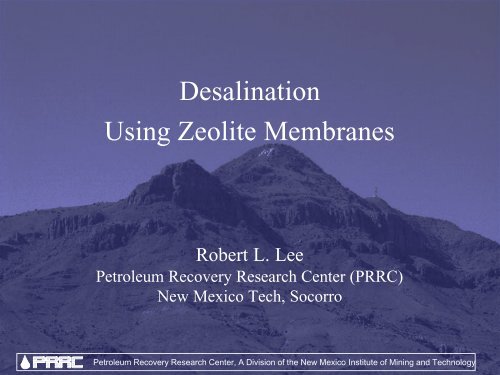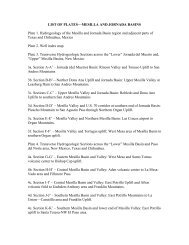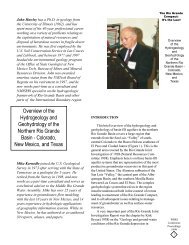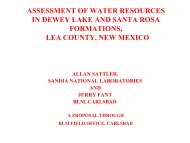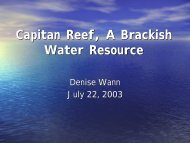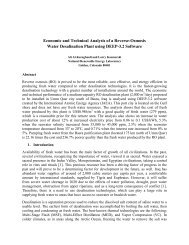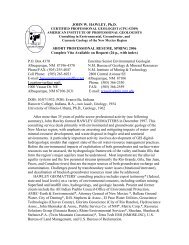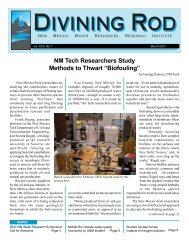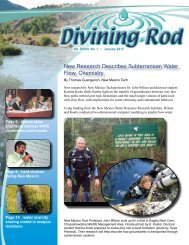Desalination Using Zeolite Membranes - Water Resources ...
Desalination Using Zeolite Membranes - Water Resources ...
Desalination Using Zeolite Membranes - Water Resources ...
- No tags were found...
Create successful ePaper yourself
Turn your PDF publications into a flip-book with our unique Google optimized e-Paper software.
<strong>Desalination</strong><strong>Using</strong> <strong>Zeolite</strong> <strong>Membranes</strong>Robert L. LeePetroleum Recovery Research Center (PRRC)New Mexico Tech, SocorroPetroleum Recovery Research Center, A Division of the New Mexico Institute of Mining and Technology
PRRC/NM Tech:• A research arm of New Mexico oil and gas industry, only for oiland gas industry, dedicated to industry’s interests alone.• PRRC/NM Tech research directions are governed by its advisoryboard members including:(1) New Mexico Oil & Gas Association (NMOGA)(2) Independent Producers Association (IPANM)(3) New Mexico Oil Conservation Division (NMOCD)(4) New Mexico State Land Office (NMSLO)• NMOGA, IPANM, NMOCD, and SLO are policy-makingorganizations but PRRC/NM Tech is for research only.Petroleum Recovery Research Center, A Division of the New Mexico Institute of Mining and Technology
PRRC Produced <strong>Water</strong> Research• <strong>Water</strong> Shutoff and Conformance Improvement(Seright, PRRC/NM Tech)• Optimal Process Identification(Hightower, Sattler, Sandia)• Produced <strong>Water</strong> Quality Data/Mapping(Cather, PRRC/NM Tech)• Brine Treatment Innovations, <strong>Water</strong>Dog(Dong, PRRC/NM Tech)Petroleum Recovery Research Center, A Division of the New Mexico Institute of Mining and Technology
• Funding:Funding & Acknowledgements– 1/3 of PRRC/NM Tech’s resources are devoted to producedwater projects.– Current contracted budget: ~ $3.6M• Acknowledgements:– NPTO/NETL/DOE ~ $2.0M– State of New Mexico ~ $1.4M– NM Tech President Office ~ $0.2M– Endorsements from NMOGA, IPANM, NMOCD, and SLOPetroleum Recovery Research Center, A Division of the New Mexico Institute of Mining and Technology
<strong>Water</strong>Dog Phase I, 1998-20021) In 1998, PRRC/NM Tech started its desalinationresearch effort.2) Research focused on high-salinity produced water:- >> 50,000 ppm in San Juan basin- >> 100,000 ppm in Permian basin3) 1999-2002 (Whitworth), studied compactedbentonite clay membranes. Unfortunately, thecharged layers are destroyed in highly concentratedbrines.Petroleum Recovery Research Center, A Division of the New Mexico Institute of Mining and Technology
<strong>Water</strong>Dog Phase II, 2003 --• The new synthetic <strong>Zeolite</strong> membrane wassuccessfully tested by Dr. Dong’s group atPRRC/NM Tech.• The <strong>Zeolite</strong> membrane has ~ 90% salt rejection rateof an 80,000 ppm produced water.• It is an inorganic membrane.• It should be easy to manufacture, is promising to becommercialized…………………..• The patent application was filed in May 2003.Petroleum Recovery Research Center, A Division of the New Mexico Institute of Mining and Technology
Polycrystalline <strong>Zeolite</strong> <strong>Membranes</strong>for produced water treatmentLiangxiong, Li a,b ; Junhang, Dong a ; Robert L. Lee baDepartment of Petroleum & Chemical EngineeringbPetroleum Recovery Research Center (PRRC)New Mexico Tech, Socorro
Introduction• Produced water treatment– High salt concentration (as high as 20 wt%, 200,000 ppm)– Dissolvable hydrocarbon– High cost of treatment (∼$1.7/barrel)• Polymeric membrane– Serious hydrolysis at produced water condition– Sensitive to pH changes• Inorganic membrane– High flux ($$)– High thermal and chemical stability ($$)– Regeneration capability ($$)– Perhaps, low pretreatment cost ($$$$$$)
<strong>Zeolite</strong> Membrane SynthesisNucleationFilm formationCrystal growthSynthesis methods used:• In-situ crystallization• Second growth• Vapor phase conversionContinuous zeolite layerPorous a-alumina support
Salt Removal ExperimentHigh pressureN 2 from cylinderFeedsolutionFeed pressure control andpressure gaugeFeedtankSampleanalysisFeedoutletFlow controlvalveMembranecellSamplecollector<strong>Water</strong> bottle toprevent sampleevaporation
Mechanisms of Ion Removal by <strong>Zeolite</strong> MembraneMechanism ASize exclusionPore size5.6Å(0.56 nano)Mechanism BDouble layerOverlapping(inter crystals)IonHydrated Diameter(Angstroms)H 2O5.6Li +Na + 7.6K + 7.2Mg ++ 6.6Ca ++ 8.68.2OH - 6.0Cl - 6.6NO3 - 6.8
<strong>Zeolite</strong> Membrane--Image of Surface• In situ crystallization
<strong>Zeolite</strong> Membrane--Image of Cross-Section<strong>Zeolite</strong>AluminaSupport
XRD Pattern of <strong>Zeolite</strong> LayerMFI type zeolite<strong>Zeolite</strong> MembraneRelative Intensitya-alumina substrate0 10 20 30 40 502q
Ion Removal Testing of BrineNumberIons in feedsolutionTDS(·10 4 mg/l)Pressure(MPa)Ion Rejection(R, %)Flux(kg/m 2 .h)AZA01K + ,Na + ,Ca 2+ ,Mg 2+, NH 4+, and Cl -3.92(39K ppm)2.41(350 psi)74.5%0.112AZS04Na + , and Cl -0.552.0789.2%0.135BZA04Mg 2+ , and Cl -0.942.0768.6%0.081BZA05Ca 2+ , and Cl -1.102.0757.6%0.096BZA06Na + , and SO 42-1.422.0757.4%0.097EZA01Na + , and Cl -0.502.0776.8%0.240R =( Cs)feed( C− ( Cs)feeds)perm× 100%F=QwA ⋅ ∆tm
Ion Removal Testing of BrineMembrane-AZA01Membrane-AZS04-2 -1Flux, kg m h0.400.350.300.250.200.15FluxRejection8070605040302010Rejection (R), %Flux (kg/(m2.h))1.201.000.800.600.40FluxRejection100%90%80%70%60%50%40%30%Ion rejection (%)0.100-100.2020%10%0 20 40 60 80 100Time, h0.000%0 20 40 60 80 100 120 140 160 180 200Time (hours)TDS, 3.92·10 4 mg/lIon rejection, 74.5%Flux, 0.112 (kg/m 2 .h)TDS (0.55·10 4 mg/l)Ion rejection, 89.2%Flux, 0.135 (kg/m 2 .h)
Separation and Flux at Different Temperature3.580Flux (Kg/(m 2 .h))Permeance (Kg/(Mpa.m 2 .h))3.02.52.01.51.00.50.0FluxPermeanceSeparation efficiency (%)70605040302010Na +K +Ca 2+NH 4+Mg 2+0 20 40 60 80 100Temperature ( o C)00 20 40 60 80 100Temperature ( o C)a. Flux vs. temperature b. Separation vs. temperature
Separation for Various Ions (Membrane BZA)80Salt rejection (%)6040200Na + K + Ca 2+ Mg 2+ SO 42-IonBr - Cl -
Summary• <strong>Zeolite</strong> membranes show promising properties for ion removal inproduced water.• The preliminary ion removal cross-flow experiment revealed that:- MFI <strong>Zeolite</strong> membrane shows salt rejection of 75% in 4×10 4 mg/l brineand 90% for 5500mg/l sodium chloride solution.- Thin and defect-free <strong>Zeolite</strong> membranes may show high ion rejectionand high flux for application in produced water treatment.
Summary• Future work:- Optimize <strong>Zeolite</strong> synthesis to minimize the cost of membranepreparation;- Synthesize and test the desalination of A-type and Y-type<strong>Zeolite</strong> membranes;- Study the mechanism of ion rejection by various types of<strong>Zeolite</strong> membrane.
PRRC Separation group members:Dr. Junhang Dong (group leader)Ashlee RyanXuehong GuAditi MajumdarKatsuya SugimotoAmber WoodyattLiangxiong LiAcknowledgementNPTO/NETL/DOE (Dr. Lawson, John Ford)State of New Mexico (Governor, Senators, Representatives)NM Tech President Office (Dr. Lopez)NMOGA, IPANM, NMOCD, and SLO(Bob Gallagher, Deborah Seligman, Jeff Harvard,Tucker Bayless, Lori Wrotenbery, and Jami Baily)


